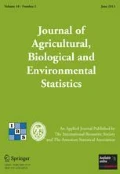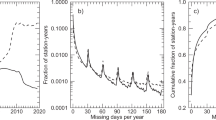Abstract
A climate model is a computer implementation of a mathematical model for the physical, chemical and biological processes underlying the climate. An immediate use of a climate model is in performing climate model experiments, where uncertain input quantities, such as greenhouse gas and aerosol concentrations, are systematically varied to gain insight into their effects on the climate system. Climate models are computationally intensive, allowing only small experiments. We present a multidimensional kriging method to predict climate model variables at new inputs, based on the experimental data available. The method is particularly suitable for situations in which the climate model data sets share a common pattern across the input space, such as surface temperatures that are lower at the Poles, higher at the Equator, and increasing over time. The results demonstrate the potential of our kriging method as an exploratory tool in climate science.
Similar content being viewed by others
References
Bayarri, M. J., Walsh, D., Berger, J. O., Cafeo, J., Garcia-Donato, G., Liu, F., Palomo, J., Parthasarathy, R. J., Paulo, R., and Sacks, J. (2007), “Computer Model Validation With Functional Output,” Annals of Statistics, 35, 1874–1906.
Currin, C., Mitchell, T., Morris, M., and Ylvisaker, D. (1991), “Bayesian Prediction of Deterministic Functions, With Applications to the Design and Analysis of Computer Experiments,”, Journal of the American Statistical Association, 86, 953–963.
Drignei, D. (2006), “Empirical Bayesian Analysis for High-Dimensional Computer Output,” Technometrics, 48, 230–240.
Drignei, D., and Morris, M. D. (2006), “Empirical Bayesian Analysis for Computer Experiments Involving Finite-Difference Codes,” Journal of the American Statistical Association, 101, 1527–1536.
Drignei, D., Forest, C., and Nychka, D. (2008), “Parameter Estimation for Computationally Intensive Nonlinear Regression With an Application to Climate Modeling,” Annals of Applied Statistics, 2, 1217–1230.
Fang, K. T., Li, R., and Sudjianto, A. (2006), Design and Modeling for Computer Experiments, Boca Raton, FL: Chapman & Hall.
Forest, C. E., Stone, P. H., Sokolov, A. P., Allen, M. R., and Webster, M. D. (2002), “Quantifying Uncertainties in Climate System Properties With the Use of Recent Climate Observations,” Science, 295, 113–117.
IPCC (2001), Climate Change 2001: The Scientific Basis. Contribution of Working Group I to the Third Assessment Report of the Intergovernmental Panel on Climate Change, eds. J. T. Houghton, Y. Ding, D. J. Griggs, M. Noguer, P. J. van der Linden, X. Dai, K. Maskell, and C. A. Johnson, Cambridge, U.K. and New York: Cambridge University Press, 881 pp.
— (2007), Climate Change 2007: The Physical Science Basis. Contribution of Working Group I to the Fourth Assessment Report of the Intergovernmental Panel on Climate Change, eds. S. Solomon, D. Qin, M. Manning, Z. Chen, M. Marquis, K. B. Averyt, M. Tignor, and H. L. Miller, Cambridge, U.K. and New York: Cambridge University Press, 996 pp.
Genton, M. G. (2007), “Separable Approximations of Space-Time Covariance Matrices,” Environmetrics, 18, 681–695.
Higdon, D., Gattiker, J., Williams, B., and Rightley, M. (2007), “Computer Model Validation Using High Dimensional Outputs,” in Bayesian Statistics 8, eds. J. Bernardo, A. P. Dawid, J. O. Berger, D. Heckerman, A. F. M. Smith, and M. West, London: Oxford University Press.
Hughes-Olivier, J. M., Gonzales-Farias, G., Lu, J. C., and Chen, D. (1998), “Parametric Nonstationary Correlation Models,” Statistics and Probability Letters, 40, 267–278.
Johnson, M., Moore, L., and Ylvisaker, D. (1990), “Minimax and Maximin Distance Designs,” Journal of Statistical Planning and Inference, 26, 131–148.
Li, R., and Sudjianto, A. (2005), “Analysis of Computer Experiments Using Penalized Likelihood in Gaussian Kriging Models,” Technometrics, 47, 111–120.
Rauthe, H., Hense, A., and Paeth, H. (2004), “A Model Intercomparison Study of Climate Change Signals in Extratropical Circulation,” International Journal of Climatology, 24, 643–662.
Sacks, J., Welch, W. J., Mitchell, T. J., and Wynn, H. P. (1989), “Design and Analysis of Computer Experiments,” Statistical Science, 4, 409–423.
Santner, T. J., Williams, B. J., and Notz, W. I. (2003), The Design and Analysis of Computer Experiments, New York: Springer.
Schabenberger, O., and Gotway, C. A. (2005), Statistical Methods for Spatial Data Analysis, Boca Raton, FL: Chapman & Hall.
Sokolov, A. P., and Stone, P. H. (1998), “A Flexible Climate Model for Use in Integrated Assessments,” Climate Dynamics, 14, 291–303.
Stone, P. H., and Yao, M. S. (1987), “Development of a Two-Dimensional Zonally Averaged Statistical-Dynamical Model. II: The Role of Eddy Momentum Fluxes in the General Circulation and Their Parametrization,” Journal of the Atmospheric Sciences, 44, 3769–3786.
— (1990), “Development of a Two-Dimensional Zonally Averaged Statistical-Dynamical Model. III: Parametrization of the Eddy Fluxes of Heat and Moisture,” Journal of Climate, 3, 726–740.
Yao, M. S., and Stone, P. H. (1987), “Development of a Two-Dimensional Zonally Averaged Statistical-Dynamical Model. I: The Parameterization of Moist Convection and Its Role in the General Circulation,” Journal of the Atmospheric Sciences, 44, 65–82.
Author information
Authors and Affiliations
Corresponding author
Rights and permissions
About this article
Cite this article
Drignei, D. A kriging approach to the analysis of climate model experiments. JABES 14, 99–114 (2009). https://doi.org/10.1198/jabes.2009.0006
Received:
Revised:
Issue Date:
DOI: https://doi.org/10.1198/jabes.2009.0006




